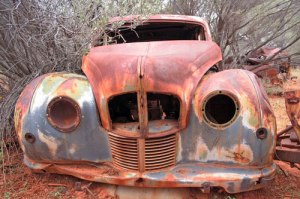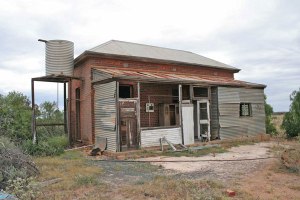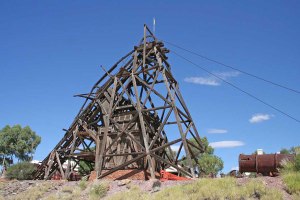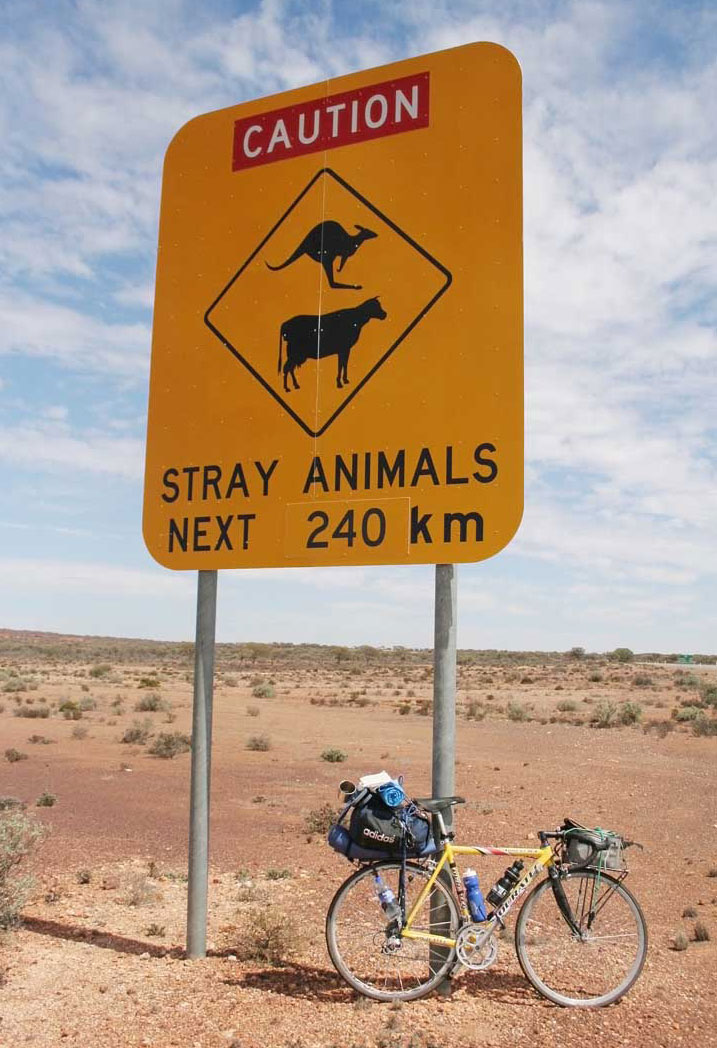Bruce Hunt finds the bike the perfect vehicle to seek the ghosts of Western Australia’s faded goldfield towns.
The mania for gold which ignited the explosion of population in Western Australia in the late nineteenth century must have been spectacular to live through. During my experience of the Northern Goldfields, I could sense the presence of the pioneers who gave up everything in the pursuit of a dream of riches beyond imagination.
Key to the experience was my trusty old road bicycle. Of course it is possible to drive to the abandoned towns and mine sites out there, but to get a real sense of the ghosts that linger doing it without the internal combustion engine brings you at least one step closer. For they were epic human struggles that took place there, struggles that are present in the unique landscape, the poignant remains dotted all over the bush.
I clocked up just over 1,200 kilometres in 12 days, during which I relived a time out of the past.

My tour of the Goldfield ghost towns nearly ended before it began. I planned to start, appropriately, in Midland, the town whose origin and history are bound up with the railway and the gold rushes. The Prospector train to Kalgoorlie was surely the way to embark on this time travel?
The uniformed lady railway official with the clip-board did not think so. Looking at my partly dismantled bike wrapped in plastic, she was adamant: “Bikes aren’t allowed on the Prospector”. The discussion circled around whether or not it was a ‘fold-up bike’ and even if bikes were permitted at all. The station master was consulted and finally the train driver, who saw no problem at all. I was on my way, for an extra $20, but wondered if Irish gold rush pioneer Paddy Hannan was revisiting Kalgoorlie today, could he get on the Prospector with his kit?
Out of Kalgoorlie, battling into strong winds for 135km I made my first overnight camp in the ‘ghost town’ of Menzies, population of about sixty. After a good night’s sleep I did some exploring on the red dirt roads around the town. Immediately the atmosphere of the gold-rush years presents in the architecture of the town hall, the pub, the railway station, a few houses and some long since closed shops.
At its height in the early 1900s more than a dozen mines were working and amazingly, Menzies was a throbbing town of 10,000 souls, with 13 hotels, three banks, its own breweries and cordial factory, a post office with a staff of 25, a school with 205 pupils, a public library, four churches and a railway station with four trains a day to and from Kalgoorlie. If you listen closely, you can still hear the faint echo of the honky-tonk piano from the saloon bars, the real Wild West, as opposed to the pale Hollywood recreation.

My own pioneering spirit was just about to be tested, even if I didn’t know it. My first puncture wasn’t going to be a big deal, I thought, until I discovered that somewhere along the way my bicycle pump had begun to shake itself apart and was now totally useless. If there ever was one, there was certainly no bike shop here now. It was time for a quick excursion back into the 21st century—I hitched a ride. The Good Samaritan was Keith, a 76-year-old school bus driver for the 32 indigenous children of the district. He was a living history book—born in Menzies and lived there all his life. All the way to ‘Kal’, he brought back to life the dead settlements along the way, places with names like Comet Vale, Bardoc, Broad Arrow and Goongarrie.
Back in Menzies with my new pump, I was soon on the road to the old Menzies cemetery where the headstones whispered of the hardships and tragedies of long-dead miners and their families, buried so far from their birthplaces in Europe. Judging by the surnames, a great number were from Ireland. Predictably, many men died in mining accidents but, heartbreakingly, I learned that so many wives and children died from cholera and typhoid. Sad, as I had in my pack the 21st century answer to water-borne bugs, Acquatabs, the water purifying tablets made in Wexford, Ireland.
Back on the road out of Menzies, there was no let-up in the head wind as I battled towards Kookynie with a detour to the Niagara Dam. Niagara was meant to be the town where steam locomotives took on water but by the time the dam was built, they had found lots of groundwater. It was a big white elephant, but now it’s a great spot for a picnic.

Up the road is Kookynie, a booming town in the gold-rush era, when it boasted a racecourse, shops and factories, a brewery, eleven hotels, including The Grand Hotel built in 1902 and still going. I heard that Kookynie even had a red light district run by local Japanese residents. It was also the first town in the Western Australian Goldfields to have a swimming baths. In 1907 the town had a population of well over 3,500, now shrunk to just seven people.
The abandoned mine shafts, deserted homes and shops are preserved as in a huge open-air museum, with touching reminders of lives which seem to have simply been switched off at a moment in time. I filled four bottles of bore water and I was back on the bumpy 60km gravel track to Leonora.
As the temperature rose into the 30s I needed all the water I could carry. The ‘road’ was a bit tricky with lots of soft sand interspersed with loose gravel and some seriously bumpy sections. After two hours I had only clocked 25km and had already got through two bottles of water.
My pioneering abilities were about to be tested again. When I checked the bike frame bottle cage, my reserve water was gone. The bottles had shaken fee and were lost somewhere back down the track. Fortunately there was just enough water in some of the gullies beside the track to fill my empty bottles, trying not to disturb the red muddy sediment. In went my trusty water tablets from far-away Wexford and so, on to Leonora.

Leonora lies 230km north of Kalgoorlie and has a semi-permanent population of 1,500 which includes a lot of transient gold prospectors living in the caravan park. One group of prospectors had come all the way from France, they were bitten by the gold bug and had come dreaming of a fortune still to be made in the goldfields. After a month driving around the bush in a clapped out van with a leaking radiator they had found $35 worth of gold. Their investment totalled thousands of dollars and they were rapidly going broke, a living reminder that the past is still uniquely present out here.
Same as always, the gold fever still feeds on rumour. The story was circulating in Leonora when I cycled through that a secretive old Aussie digger at the park had found two eight ounce nuggets in recent weeks. He was indeed secretive because I couldn’t find him and details were vague.
In its heyday Leonora and the nearby town of Gwalia were linked by an electric tram service. In the ghost town of Gwalia, you can almost touch the gold rush. The little settlement that grew up around the Sons of Gwalia Mine in the late 1890s thrived until the final whistle blew on 28 December 1963, closing the mine and putting 250 men out of work. Gwalia’s 1,200-strong population melted away to just 40 in less than three weeks.
The eerily intact abandoned homes and business premises of Gwalia are a tangible link with a vanished era and way of life; the little cottages built of corrugated iron, timber and whitewashed hessian still hold faint echoes of a miner’s wife cooking dinner on the cast iron range, while her husband toils underground to support his family and children.

It looks quaint and nostalgic now, like a snapshot out of the past, but the decline of mining in Gwalia was partly because people were no longer prepared to raise families in these same earth floored corrugated iron buildings.
In Mazza’s Store, the shopper could buy everything from two pounds of flour to a length of fabric. Just up the road is Patroni’s Guest House, for decades a home from home for single men working in the Sons of Gwalia Mine. The ‘town’ now has a population of about 15 people.
The following day I headed north to Leinster, a new town with no real history, custom built for workers at the nickel mine. At last the winds swung more favourably and I was happy to see the back of Leinster to begin pedalling the 160km to Sandstone.
I arrived quite late in Sandstone, but, thank goodness, the pub was still open. Two cans of beer never tasted better, that I can recall. The few locals sat at the bar with hardly a glance in my direction. They too seemed frozen in time, their glasses of beer seemingly suspended between counter and mouth. I can’t imagine that sweat covered cyclists in the middle of the desert are commonplace here, but then again, this is the ghost zone where presumably anything is possible!
Now, it’s hard to believe that Sandstone had a population of 6,000 in 1907 and was referred to as a ‘city’. It’s currently home to less than 100 people and lots of holes in the ground left by long-dead miners.
Only four more days on the road, with overnight stops at mining towns Mount Magnet, WA’s longest continually operating gold mine, and Yalgoo, but neither of these are ghost towns. On to Mullewa, and I now seem to be also moving forward through time, passing into farming country and finally the bus from Geraldton back to the 21st century (and Perth). In all I covered just over 1,200 kilometres but who can say if I was away for days, decades or centuries?
Ride On content is editorially independent, but is supported financially by members of Bicycle Network. If you enjoy our articles and want to support the future publication of high-quality content, please consider helping out by becoming a member.


